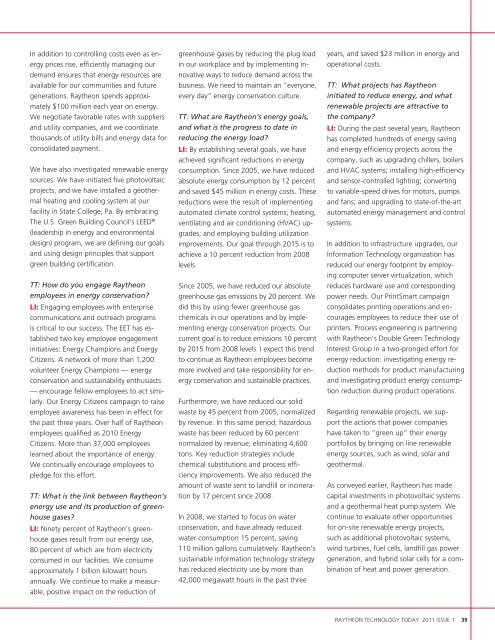Raytheon Technology Today 2011 Issue 1
Raytheon Technology Today 2011 Issue 1
Raytheon Technology Today 2011 Issue 1
Create successful ePaper yourself
Turn your PDF publications into a flip-book with our unique Google optimized e-Paper software.
In addition to controlling costs even as energy<br />
prices rise, efficiently managing our<br />
demand ensures that energy resources are<br />
available for our communities and future<br />
generations. <strong>Raytheon</strong> spends approximately<br />
$100 million each year on energy.<br />
We negotiate favorable rates with suppliers<br />
and utility companies, and we coordinate<br />
thousands of utility bills and energy data for<br />
consolidated payment.<br />
We have also investigated renewable energy<br />
sources. We have initiated five photovoltaic<br />
projects, and we have installed a geothermal<br />
heating and cooling system at our<br />
facility in State College, Pa. By embracing<br />
The U.S. Green Building Council’s LEED ®<br />
(leadership in energy and environmental<br />
design) program, we are defining our goals<br />
and using design principles that support<br />
green building certification.<br />
TT: How do you engage <strong>Raytheon</strong><br />
employees in energy conservation?<br />
LI: Engaging employees with enterprise<br />
communications and outreach programs<br />
is critical to our success. The EET has established<br />
two key employee engagement<br />
initiatives: Energy Champions and Energy<br />
Citizens. A network of more than 1,200<br />
volunteer Energy Champions — energy<br />
conservation and sustainability enthusiasts<br />
— encourage fellow employees to act similarly.<br />
Our Energy Citizens campaign to raise<br />
employee awareness has been in effect for<br />
the past three years. Over half of <strong>Raytheon</strong><br />
employees qualified as 2010 Energy<br />
Citizens. More than 37,000 employees<br />
learned about the importance of energy.<br />
We continually encourage employees to<br />
pledge for this effort.<br />
TT: What is the link between <strong>Raytheon</strong>’s<br />
energy use and its production of greenhouse<br />
gases?<br />
LI: Ninety percent of <strong>Raytheon</strong>’s greenhouse<br />
gases result from our energy use,<br />
80 percent of which are from electricity<br />
consumed in our facilities. We consume<br />
approximately 1 billion kilowatt hours<br />
annually. We continue to make a measurable,<br />
positive impact on the reduction of<br />
greenhouse gases by reducing the plug load<br />
in our workplace and by implementing innovative<br />
ways to reduce demand across the<br />
business. We need to maintain an “everyone,<br />
every day” energy conservation culture.<br />
TT: What are <strong>Raytheon</strong>’s energy goals,<br />
and what is the progress to date in<br />
reducing the energy load?<br />
LI: By establishing several goals, we have<br />
achieved significant reductions in energy<br />
consumption. Since 2005, we have reduced<br />
absolute energy consumption by 12 percent<br />
and saved $45 million in energy costs. These<br />
reductions were the result of implementing<br />
automated climate control systems; heating,<br />
ventilating and air conditioning (HVAC) upgrades;<br />
and employing building utilization<br />
improvements. Our goal through 2015 is to<br />
achieve a 10 percent reduction from 2008<br />
levels.<br />
Since 2005, we have reduced our absolute<br />
greenhouse gas emissions by 20 percent. We<br />
did this by using fewer greenhouse gas<br />
chemicals in our operations and by implementing<br />
energy conservation projects. Our<br />
current goal is to reduce emissions 10 percent<br />
by 2015 from 2008 levels. I expect this trend<br />
to continue as <strong>Raytheon</strong> employees become<br />
more involved and take responsibility for energy<br />
conservation and sustainable practices.<br />
Furthermore, we have reduced our solid<br />
waste by 45 percent from 2005, normalized<br />
by revenue. In this same period, hazardous<br />
waste has been reduced by 60 percent<br />
normalized by revenue, eliminating 4,600<br />
tons. Key reduction strategies include<br />
chemical substitutions and process efficiency<br />
improvements. We also reduced the<br />
amount of waste sent to landfill or incineration<br />
by 17 percent since 2008.<br />
In 2008, we started to focus on water<br />
conservation, and have already reduced<br />
water consumption 15 percent, saving<br />
110 million gallons cumulatively. <strong>Raytheon</strong>’s<br />
sustainable information technology strategy<br />
has reduced electricity use by more than<br />
42,000 megawatt hours in the past three<br />
years, and saved $23 million in energy and<br />
operational costs.<br />
TT: What projects has <strong>Raytheon</strong><br />
initiated to reduce energy, and what<br />
renewable projects are attractive to<br />
the company?<br />
LI: During the past several years, <strong>Raytheon</strong><br />
has completed hundreds of energy saving<br />
and energy efficiency projects across the<br />
company, such as upgrading chillers, boilers<br />
and HVAC systems; installing high-efficiency<br />
and sensor-controlled lighting; converting<br />
to variable-speed drives for motors, pumps<br />
and fans; and upgrading to state-of-the-art<br />
automated energy management and control<br />
systems.<br />
In addition to infrastructure upgrades, our<br />
Information <strong>Technology</strong> organization has<br />
reduced our energy footprint by employing<br />
computer server virtualization, which<br />
reduces hardware use and corresponding<br />
power needs. Our PrintSmart campaign<br />
consolidates printing operations and encourages<br />
employees to reduce their use of<br />
printers. Process engineering is partnering<br />
with <strong>Raytheon</strong>’s Double Green <strong>Technology</strong><br />
Interest Group in a two-pronged effort for<br />
energy reduction: investigating energy reduction<br />
methods for product manufacturing<br />
and investigating product energy consumption<br />
reduction during product operations.<br />
Regarding renewable projects, we support<br />
the actions that power companies<br />
have taken to “green up” their energy<br />
portfolios by bringing on line renewable<br />
energy sources, such as wind, solar and<br />
geothermal.<br />
As conveyed earlier, <strong>Raytheon</strong> has made<br />
capital investments in photovoltaic systems<br />
and a geothermal heat pump system. We<br />
continue to evaluate other opportunities<br />
for on-site renewable energy projects,<br />
such as additional photovoltaic systems,<br />
wind turbines, fuel cells, landfill gas power<br />
generation, and hybrid solar cells for a combination<br />
of heat and power generation.<br />
RAYTHEON TECHNOLOGY TODAY <strong>2011</strong> ISSUE 1 39

















